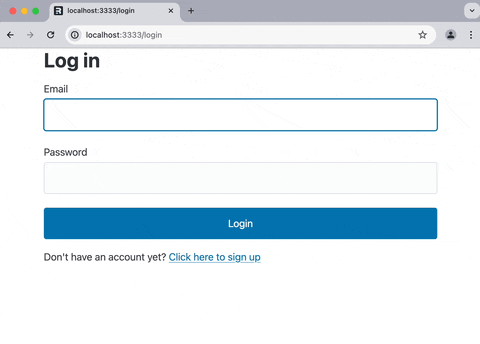I have recently created a fullstack meta-framework for Node.js that combines Remix (React) with AdonisJS (Node.js).
My goal was to create my dream stack, and I am very happy with the result. I am creating these tutorials for others to see what is possible with remix-adonisjs 🙌
You can find this tutorial in the documentation for remix-adonisjs here: https://remix-adonisjs.matstack.dev/hands-on/building-a-login-flow.html
Here is what we'll build:
Building an application often requires that you let users create accounts and log in.
This guide will show you how to:
- Create database tables for storing users and hashed passwords
- Protect routes in your application
- Register new users
- Log in existing users
- Log out users
Initial setup
Let's start by initiating our project with the following commands:
npm init adonisjs@latest -- -K="github:jarle/remix-starter-kit" --auth-guard=access_tokens --db=sqlite login-page-tutorial
node ace configure @adonisjs/lucid
Before we do anything else, let's add some css to resources/remix_app/root.tsx so our application looks nice.
Add this snippet anywhere in the <head> tag of your root.tsx component:
<link
rel="stylesheet"
href="https://cdn.jsdelivr.net/npm/@picocss/pico@2/css/pico.min.css"
/>
Setting up the database and @adonisjs/auth package
We'll protect our application with the adonisjs/auth package.
You can add it with this command:
node ace add @adonisjs/auth --guard=session
This created some new files for us as you can see in the output:
DONE: create config/auth.ts
DONE: update adonisrc.ts file
DONE: create database/migrations/create_users_table.ts
DONE: create app/models/user.ts
DONE: create app/middleware/auth_middleware.ts
DONE: create app/middleware/guest_middleware.ts
DONE: update start/kernel.ts file
DONE: update start/kernel.ts file
[ success ] Installed and configured @adonisjs/auth
The most important files are:
A table migration that sets up our users table:
// database/migrations/<timestamp>_create_users_table.ts
export default class extends BaseSchema {
protected tableName = 'users'
async up() {
this.schema.createTable(this.tableName, (table) => {
table.increments('id').notNullable()
table.string('full_name').nullable()
table.string('email', 254).notNullable().unique()
table.string('password').notNullable()
table.timestamp('created_at').notNullable()
table.timestamp('updated_at').nullable()
})
}
async down() {
this.schema.dropTable(this.tableName)
}
}
A user model that we use to interact with the table:
// #models/User.ts
const AuthFinder = withAuthFinder(() => hash.use('scrypt'), {
uids: ['email'],
passwordColumnName: 'password',
})
export default class User extends compose(BaseModel, AuthFinder) {
@column({ isPrimary: true })
declare id: number
@column()
declare fullName: string | null
@column()
declare email: string
@column()
declare password: string
@column.dateTime({ autoCreate: true })
declare createdAt: DateTime
@column.dateTime({ autoCreate: true, autoUpdate: true })
declare updatedAt: DateTime | null
}
A middleware that authenticate incoming requests for the endpoints we specify:
// #middleware/auth_middleware.ts
export default class AuthMiddleware {
redirectTo = '/login'
async handle(
ctx: HttpContext,
next: NextFn,
options: {
guards?: (keyof Authenticators)[]
} = {}
) {
await ctx.auth.authenticateUsing(options.guards, { loginRoute: this.redirectTo })
return next()
}
}
Here redirectTo is the route that the user will be sent to if they are not logged in when accessing a protected route.
We need to modify this middleware so it doesn't do any checks for the /login page, by defining some open routes and skipping the check for those routes:
if (this.openRoutes.includes(ctx.request.parsedUrl.pathname ?? '')) {
return next()
}
The middleware file should look like this:
// #middleware/auth_middleware.ts
export default class AuthMiddleware {
redirectTo = '/login'
openRoutes = [this.redirectTo, '/register']
async handle(
ctx: HttpContext,
next: NextFn,
options: {
guards?: (keyof Authenticators)[]
} = {}
) {
if (this.openRoutes.includes(ctx.request.parsedUrl.pathname ?? '')) {
return next()
}
await ctx.auth.authenticateUsing(options.guards, { loginRoute: this.redirectTo })
return next()
}
}
We should also create the user table in our database by running our new migration file:
node ace migration:run
::: info
You can always re-generate your database if you want to clear it of any data.
The command for clearing your database is:
node ace migration:fresh
:::
Applying auth middleware
Time to apply the middleware and protect our routes!
Update #start/kernel.ts and add the auth_middleware.
This will run the authentication on every remix route.
import router from '@adonisjs/core/services/router'
import { middleware } from './kernel.js'
router
.any('*', async ({ remixHandler }) => {
return remixHandler()
})
.use(
middleware.auth({
guards: ['web'],
})
)
If you try to access your app now, you should be redirected to the /login endpoint.
This redirect will give you a 404 Not Found error because we haven't made a login route yet.
Let's create the login route in Remix with this command:
node ace remix:route --action --error-boundary login
Building the auth pages
Let's create a login form to get started with our routes.
Replace your Page() function with this code and leave everything else in the file as-is for now:
export default function Page() {
return (
<div className="container">
<h1>Log in</h1>
<Form method="post">
<label>
Email
<input type="email" name="email" />
</label>
<label>
Password
<input type="password" name="password" />
</label>
<button type="submit">Login</button>
<p>
Don't have an account yet? <Link to={'/register'}>Click here to sign up</Link>
</p>
</Form>
</div>
)
}
We don't have a way to register users, so the login page isn't very useful yet.
Let's create a new route using Remix so users can register, using a similar command as before:
node ace remix:route --action --error-boundary register
Add this simple form to the Page() function:
export default function Page() {
return (
<div className="container">
<h1>Register</h1>
<Form method="post">
<label>
Email
<input type="email" name="email" />
</label>
<label>
Password
<input type="password" name="password" />
</label>
<button type="submit">Register</button>
</Form>
</div>
)
}
This is starting to look good!
But wait, clicking the Register button doesn't do anything yet 🤔
That means it's time to implement the logic for user registration.
Creating and registering a user service
To keep things tidy, we create a new service for handling users.
node ace make:service user_service
Add this code to the service:
import User from '#models/user';
import hash from '@adonisjs/core/services/hash';
export default class UserService {
async createUser(props: { email: string; password: string }) {
return await User.create({
email: props.email,
password: props.password,
})
}
async getUser(email: string) {
return await User.findByOrFail('email', email)
}
async verifyPassword(user: User, password: string) {
return hash.verify(user.password, password)
}
}
Now we need to make the service available to our /register route.
The proper way to do that is to add the service to the application container.
Update the #services/service_providers.ts file to create a new instance of our service:
import HelloService from './hello_service.js'
import UserService from './user_service.js'
// Register services that should be available in the container here
export const ServiceProviders = {
hello_service: () => new HelloService(),
user_service: () => new UserService(),
} as const
Now we have one instance of the UserService that can be accessed anywhere in our app.
Let's use the service in our /register route action function:
export const action = async ({ context }: ActionFunctionArgs) => {
const { http, make } = context
// get email and password from form data
const { email, password } = http.request.only(['email', 'password'])
// get the UserService from the app container and create user
const userService = await make('user_service')
const user = await userService.createUser({
email,
password,
})
// log in the user after successful registration
await http.auth.use('web').login(user)
return redirect('/')
}
Registering a user
You can now try to run your app and register a new user.
If you have followed all the steps, you should be redirected to the index page after registering.
Let's make an indicator so that we can see we are actually logged in.
Let's update _index.tsx to have this loader, where we get the email of the currently authenticated user:
// resources/remix_app/routes/_index.tsx
export const loader = async ({ context }: LoaderFunctionArgs) => {
const email = context.http.auth.user?.email
return json({
email,
})
}
And update the Index.tsx components to display the email:
// resources/remix_app/routes/_index.tsx
export default function Index() {
const { email } = useLoaderData<typeof loader>()
return <p>Logged in as {email}</p>
}
Open your app in your application and you should see something like this displayed with the email you registered with:
Logged in as yourname@example.com
How cool is that!
We have some momentum now, so let's keep going.
Logging out
A natural next step is to be able to log out.
Let's add support for that to our index page:
Add an action to your index route to make it possible to log out:
// resources/remix_app/routes/_index.tsx
export const action = async ({ context }: ActionFunctionArgs) => {
const { http } = context
const { intent } = http.request.only(['intent'])
if (intent === 'log_out') {
await http.auth.use('web').logout()
return redirect('/login')
}
return null
}
And add a button that triggers the action:
// resources/remix_app/routes/_index.tsx
export default function Index() {
const { email } = useLoaderData<typeof loader>()
return (
<div className="container">
<p>Logged in as {email}</p>
<Form method="POST">
<input type="hidden" name="intent" value={'log_out'} />
<button type={'submit'}>Log out</button>
</Form>
</div>
)
}
Now it should be possible to log out clicking the Log out button on the front page.
We are redirected to the login page after logging out, but we haven't finished that page yet: we need to add login functionality.
Logging in
Let's add the following action to the login page:
import { ActionFunctionArgs, redirect } from '@remix-run/node'
export const action = async ({ context }: ActionFunctionArgs) => {
const { http, make } = context
// get the form email and password
const { email, password } = http.request.only(['email', 'password'])
const userService = await make('user_service')
// look up the user by email
const user = await userService.getUser(email)
// check if the password is correct
await userService.verifyPassword(user, password)
// log in user since they passed the check
await http.auth.use('web').login(user)
return redirect('/')
}
Now we should have a complete flow for registering new users and for logging users in and out!
Conclusion
We have covered a lot of the parts that makes remix-adonisjs great, and we have only scratched the surface.
There is a lot to learn, and I will continue making these guides to make the meta framework more accessible and familiar to work with.
If you want to dig deeper into what the framework can do, check out the documentation pages here: https://remix-adonisjs.matstack.dev/
And don't hesitate to share your questions and feedback in the comments!







Top comments (0)